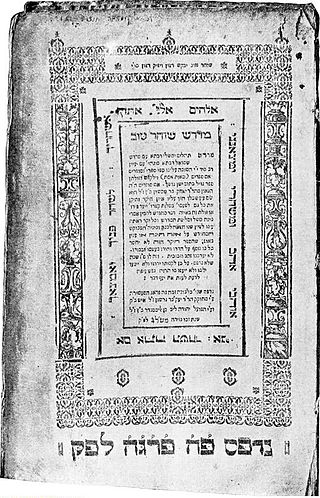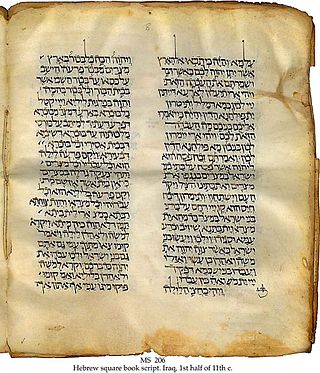Halakha, also transliterated as halacha, halakhah, and halocho, is the collective body of Jewish religious laws that are derived from the Written and Oral Torah. Halakha is based on biblical commandments (mitzvot), subsequent Talmudic and rabbinic laws, and the customs and traditions which were compiled in the many books such as the Shulchan Aruch. Halakha is often translated as "Jewish law", although a more literal translation of it might be "the way to behave" or "the way of walking". The word is derived from the root which means "to behave". Halakha not only guides religious practices and beliefs, it also guides numerous aspects of day-to-day life.

Jacob Neusner was an American academic scholar of Judaism. He was named as one of the most published authors in history, having written or edited more than 900 books.

Midrash is expansive Jewish Biblical exegesis using a rabbinic mode of interpretation prominent in the Talmud. The word itself means "textual interpretation", "study", or "exegesis", derived from the root verb darash (דָּרַשׁ), which means "resort to, seek, seek with care, enquire, require", forms of which appear frequently in the Hebrew Bible.

The Septuagint, sometimes referred to as the Greek Old Testament or The Translation of the Seventy, and often abbreviated as LXX, is the earliest extant Greek translation of the Hebrew Bible from the original Hebrew. The full Greek title derives from the story recorded in the Letter of Aristeas to Philocrates that "the laws of the Jews" were translated into the Greek language at the request of Ptolemy II Philadelphus by seventy-two Hebrew translators—six from each of the Twelve Tribes of Israel.

The Hebrew Bible or Tanakh, also known in Hebrew as Miqra, is the canonical collection of Hebrew scriptures, including the Torah, the Nevi'im, and the Ketuvim. Different branches of Judaism and Samaritanism have maintained different versions of the canon, including the 3rd-century Septuagint text used in Second Temple Judaism, the Syriac Peshitta, the Samaritan Pentateuch, the Dead Sea Scrolls, and most recently the 10th-century medieval Masoretic Text compiled by the Masoretes, currently used in Rabbinic Judaism. The terms "Hebrew Bible" or "Hebrew Canon" are frequently confused with the Masoretic Text; however, this is a medieval version and one of several texts considered authoritative by different types of Judaism throughout history. The current edition of the Masoretic Text is mostly in Biblical Hebrew, with a few passages in Biblical Aramaic.

A targum was an originally spoken translation of the Hebrew Bible that a professional translator would give in the common language of the listeners when that was not Hebrew. This had become necessary near the end of the first century BC, as the common language was Aramaic and Hebrew was used for little more than schooling and worship. The translator frequently expanded his translation with paraphrases, explanations and examples, so it became a kind of sermon.
The Pharisees were a Jewish social movement and a school of thought in the Levant during the time of Second Temple Judaism. After the destruction of the Second Temple in 70 CE, Pharisaic beliefs became the foundational, liturgical, and ritualistic basis for Rabbinic Judaism.
The Ketuvim is the third and final section of the Tanakh, after Torah ("instruction") and Nevi'im ("prophets"). In English translations of the Hebrew Bible, this section is usually titled "Writings" or "Hagiographa".

Targum Jonathan, otherwise referred to as Targum Yonasan/Yonatan, is the official eastern (Babylonian) targum to the Nevi'im ("prophets").

A Mikraot Gedolot, often called the "Rabbinic Bible" in English, is an edition of the Hebrew Bible that generally includes three distinct elements:
This is a list of books by Jacob Neusner. Articles, reviews, etc. are not included here.
Jewish commentaries on the Bible are biblical commentaries of the Hebrew Bible from a Jewish perspective. Translations into Aramaic and English, and some universally accepted Jewish commentaries with notes on their method of approach and also some modern translations into English with notes are listed.
The Targum of Lamentations (TgLam) is an Aramaic rendering of the biblical Book of Lamentations. Like all other targumim, TgLam renders the biblical book into Aramaic while incorporating rabbinic interpretations into the resultant text. TgLam probably originated in the early centuries of the Common Era as a result of Lamentations' use in the liturgical worship of Tisha b’Av, the day commemorating the destruction of Jerusalem. Reference to the use of a targum of Lamentations during Tisha b'Av services appears in the seventh-century text Soferim (42b). The extant versions of TgLam incorporate rabbinic traditions and may date to as late as the eighth century CE. The earliest manuscript of TgLam is Codex Solger MS 1-7.2∫, dated 1291 CE. TgLam's Aramaic mixes elements of eastern and western dialects. There are two primary textual traditions, that of western texts and those of Yemenite provenance.
There is no scholarly consensus as to when the Hebrew Bible canon was fixed. Some scholars argue that it was fixed by the Hasmonean dynasty, while others argue it was not fixed until the second century CE or even later.
Bruce D. Chilton is an American scholar of early Christianity and Judaism, and an Episcopalian priest. He is Bernard Iddings Bell Professor of Religion at Bard College, formerly Lillian Claus Professor of New Testament at Yale University, and Rector of the Church of St John the Evangelist He holds a PhD in New Testament from Cambridge University. He has previously held academic positions at the Universities of Cambridge, Sheffield, and Münster.
Ruth Langer is a Professor of Theology at Boston College, and an expert on Jewish Liturgy and on Christian Jewish Relations. She is married to Jonathan Sarna.

Bible translations into Aramaic covers both Jewish translations into Aramaic (Targum) and Christian translations into Aramaic, also called Syriac (Peshitta).

Targum Neofiti is the largest of the Western Targumim on the Torah, or Palestinian Targumim. The extant copy consists of 450 folios covering all books of the Torah, with only a few damaged verses.
Robert Patterson Gordon is a British scholar who was the Regius Professor of Hebrew at the University of Cambridge from 1995 to 2012.
Charles Thomas Robert Hayward is a British academic and convicted sex offender. He had been Professor of Hebrew in the Department of Theology and Religion at Durham University.








